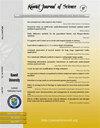盐胁迫下红花的生理生化响应
IF 1.1
4区 综合性期刊
Q3 MULTIDISCIPLINARY SCIENCES
引用次数: 0
摘要
盐胁迫是影响植物生理代谢活动的重要非生物因子之一。本研究采用完全随机设计的因子试验,于1403-1402农业年在伊拉姆大学研究温室进行。本研究对4个基因型(Cart193、Cart158、Cart83和Cart223)进行了2个水平(对照和120 mM)的盐度胁迫,评价了红花(Carthamus tinctorius L.)的生长指标、光合速率、相对含水量(RWC)、可溶性碳水化合物含量(TSC)、脯氨酸(Pro)以及酶和非酶抗氧化剂。与对照相比,car83和car158基因型地上部分的株高和穗数分别降低了6.2%和23.07%。单株种子数、种子重25%、总种子产量24.39%、生物产量18.86%、收获指数19.89%、穗直径0.78%、光合速率1.82%、RWC 31.74%均较对照降低。此外,与对照相比,基因型Cart193的Pro含量(25.71%)、TSC含量(29.45%)、花青素含量(42.38%)和酚类物质含量(31.22%)增加最多。然而,在酶促抗氧化剂中,只有愈创木酚过氧化物酶(GPX)在Cart223基因型中比对照增加了55.05%。研究结果表明,相容的渗透产物和非酶促抗氧化剂可作为了解红花在盐胁迫条件下防御机制的有效标记物。本文章由计算机程序翻译,如有差异,请以英文原文为准。
Physiological and biochemical responses of Carthamus tinctorius L. under salt stress
Salinity stress is one of the important abiotic factors that affect the physiological and metabolic activities of plants. The present research was conducted in a factorial experiment based on a completely randomized design in the research greenhouse of Ilam University during the agricultural year 1403–1402. In this study, salinity stress at two levels (control and 120 mM) was applied to four genotypes (Cart193, Cart158, Cart83, and Cart223) to evaluate growth indices, photosynthesis rate, relative water content (RWC), soluble carbohydrate content (TSC), proline (Pro), and enzymatic and non-enzymatic antioxidants in Carthamus tinctorius L. The mean comparison results showed that under 120 mM salinity stress, the aerial parts had a reduction of 6.2 % in plant height and 23.07 % in the number of seeds per head, respectively, in the genotypes Cart83 and Cart158 compared to the control. Additionally, the number of seeds per head, 25 % seed weight, 24.39 % total seed yield, 18.86 % biological yield, 19.89 % harvest index, 0.78 % head diameter, 1.82 % photosynthesis rate 60 %, and RWC 31.74 % showed the highest reduction in the genotype Cart223 compared to the control. Furthermore, the content of 25.71 % Pro, 29.45 % TSC, 42.38 % anthocyanins, and 31.22 % phenols showed the highest increase in the genotype Cart193 compared to the control. However, among the enzymatic antioxidants, only guaiacol peroxidase (GPX) showed the highest increase of 55.05 % in the genotype Cart223 compared to the control. The results of this study indicate that compatible osmolytes and non-enzymatic antioxidants act as effective markers for understanding the defense mechanisms of Carthamus tinctorius under salinity stress conditions.
求助全文
通过发布文献求助,成功后即可免费获取论文全文。
去求助
来源期刊

Kuwait Journal of Science
MULTIDISCIPLINARY SCIENCES-
CiteScore
1.60
自引率
28.60%
发文量
132
期刊介绍:
Kuwait Journal of Science (KJS) is indexed and abstracted by major publishing houses such as Chemical Abstract, Science Citation Index, Current contents, Mathematics Abstract, Micribiological Abstracts etc. KJS publishes peer-review articles in various fields of Science including Mathematics, Computer Science, Physics, Statistics, Biology, Chemistry and Earth & Environmental Sciences. In addition, it also aims to bring the results of scientific research carried out under a variety of intellectual traditions and organizations to the attention of specialized scholarly readership. As such, the publisher expects the submission of original manuscripts which contain analysis and solutions about important theoretical, empirical and normative issues.
 求助内容:
求助内容: 应助结果提醒方式:
应助结果提醒方式:


